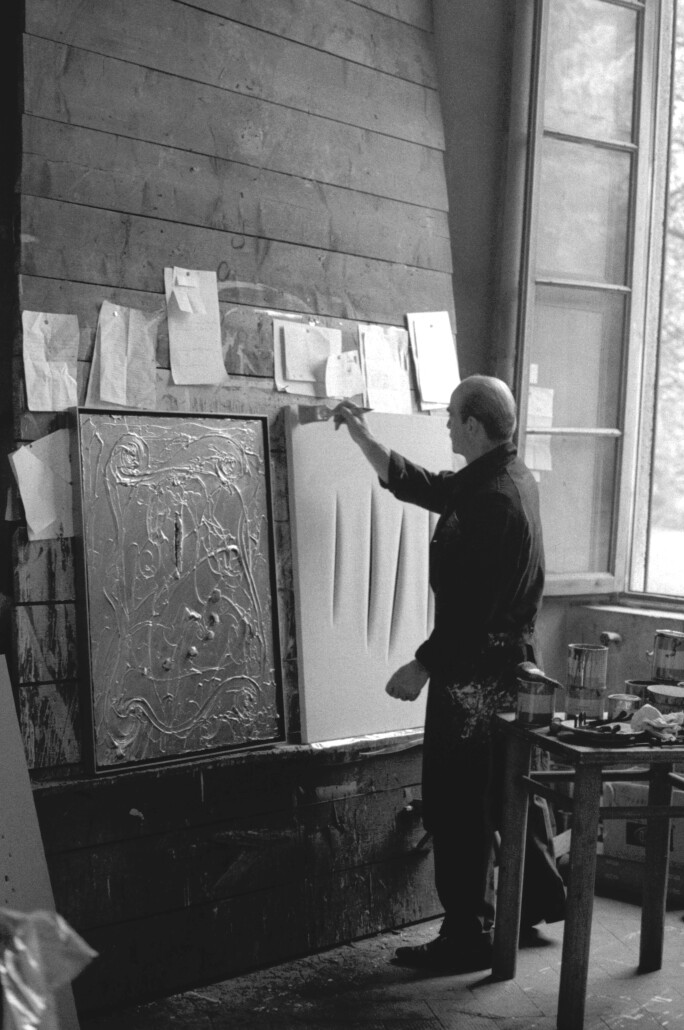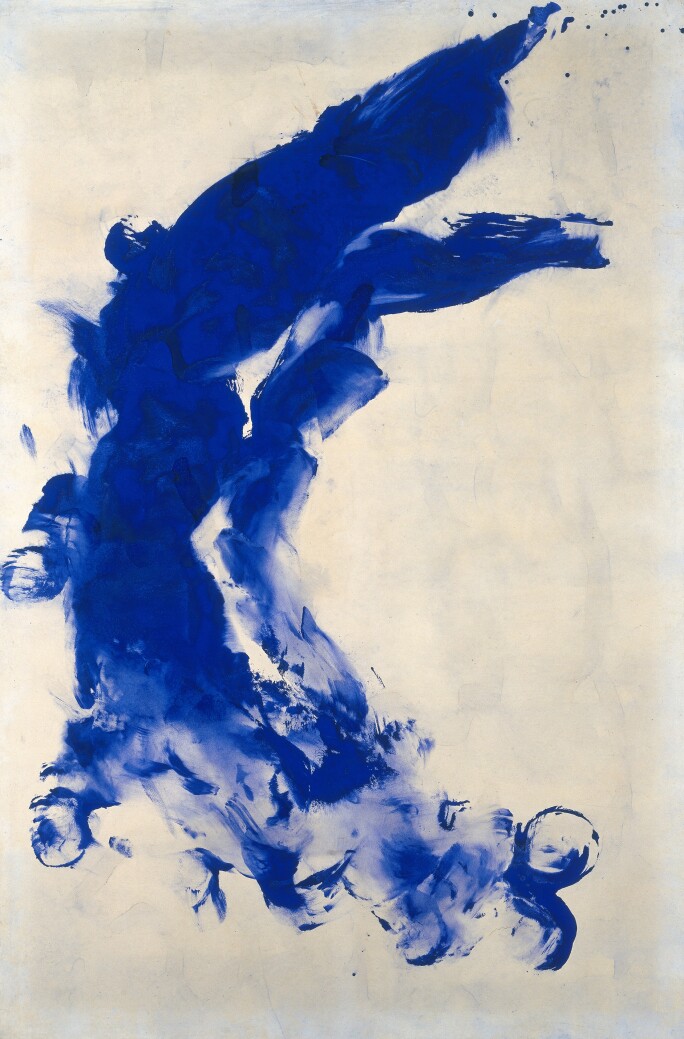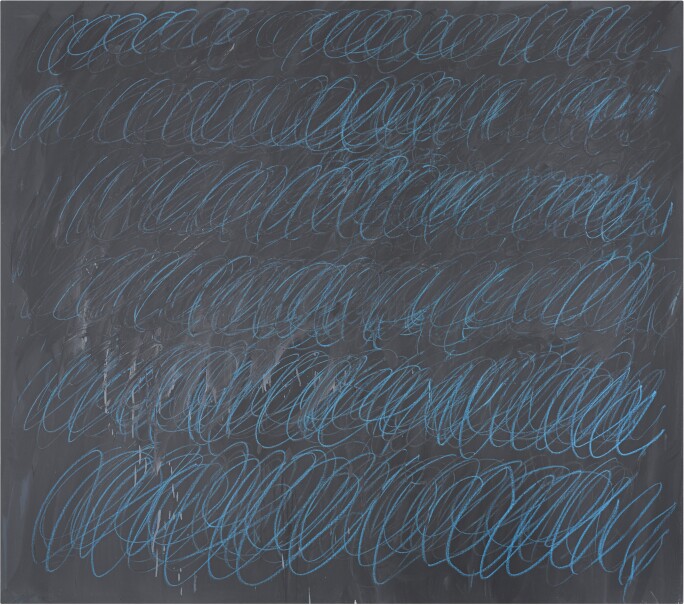“My cuts are above all a philosophical statement, an act of faith in the infinite, an affirmation of spirituality. When I sit down to contemplate one of my cuts, I sense all at once an enlargement of the spirit, I feel like a man freed from the shackles of matter; a man at one with the immensity of the present and of the future.”

Rendered in deep azure blue, Concetto spaziale, Attese is a captivating example of Lucio Fontana’s celebrated series of slashed canvases. Rhythmic and elegant, the syncopated progression of incisions dance across the canvas and are archetypal and exemplary of the artist’s famed Tagli series rendered in a deep and contemplative hue. The rich vitality of the vivid blue pigment is immediately impactful, its saturated intensity amplified through contrast with the plunging black voids. Bristling with connotations, this canvas is charged with the colour of calm and serenity – of meditative introspection and allusion to the natural world. Its abundant richness is tempered only by the punctuating presence of five deep and lyrical slashes, each imbued with a fleeting, dance-like vigour, as if part of an immutable crescendo of beauty and brutality.

Image: © Photo Ugo Mulas © Ugo Mulas Heirs. All rights reserved.
Artwork: © Lucio Fontana/SIAE/DACS, London 2022
The artistic theory behind the creation of the Tagli (cuts) was professed in Fontana’s first manifesto, the Manifiesto Bianco, published in 1946. Here Fontana proposed the birth of a new Spatialist art, which sought to articulate the fourth dimension. Alluring and hypnotic in their rhythmic intervals, the tagli transport the viewer into a dynamic and sculptural realm of space and depth, perfectly epitomising Fontana’s intent “to give the spectator an impression of spatial calm, of cosmic rigour, of serenity in infinity” (Lucio Fontana quoted in: Enrico Crispolti, Lucio Fontana, Catalogo ragionata di sculture, dipinti, ambientazioni, tomo I, Milan 2006, p. 105). In this quest, Fontana proposed the artist as the source of creative energy: Anticipating future events and engaging with technological advancement, he asserted that the artist’s work should aspire to enlighten ordinary people to the possibilities offered by their environment and society. Thus, ever since first puncturing a canvas in 1949, Fontana had been singularly committed to the Spatialist mission to explore the conceptual depths beyond the limits of the two-dimensional picture plane.

Museum Ludwig, Cologne
Images: © ADAGP Images, Paris / Scala, Florence
Artwork: © Succession Yves Klein c/o ADAGP, Paris and DACS, London 2022
With its electric blue palette and dynamic slashes, Concetto spaziale, Attese echoes Yves Klein’s Anthropometrie series whereby Klein famously used the human body as anthropomorphic brushes, dragging and imprinting forms across sheets of paper and canvas. Although born some 30 years apart, each artist found resonance in the other’s work, and, inspired by the searing potency of Klein’s blue, Fontana sought to imbue his own paintings with the transcendent force of this colour. In the present work, poetic incisions imbue the celestial blue canvas with rhythmic movement.
Though seemingly impulsive, the severe slashes on the surface of Fontana’s canvas are the result of a rational and surgical process of image-making. For the tagli series, Fontana’s gestural performance began by soaking his canvases with emulsion paint, which he then left to dry. After meticulously piercing the surface with a Stanley Knife, he would open the cuts gently with the edge of his blade. As a final step, Fontana inserted black gauze as interfacing behind each incision to create the illusion of infinite depth. As such, the artist’s steady hand was paramount to this process, the severe slashes revealing the highly physical nature of his works. This lyrical and gestural force evokes Cy Twombly’s automatic gesture on the surface of his blackboards. Whilst Twombly’s sophisticated transmutation of figurative motifs and expressionistic abstraction conceptually differed from Fontana’s Spatialism, both artists sought to undermine the pristine flatness of the picture plane, and thereby interrogate the boundaries of a painted canvas, so that which was considered interior might become exterior. Alluding to this great emphasis on the physicality of the artist’s visual language, Fontana himself wrote in 1948, “Art dies but is saved by gesture.” (Lucio Fontana quoted in: Exh. Cat., New York, Solomon R. Guggenheim Museum, Lucio Fontana 1899-1968: A Retrospective, 1977, p. 19)

Private Collection
Artwork: © Cy Twombly Foundation
By the 1960s, Fontana’s practice of breaking through the canvas and into a heretofore unexplored territory gained newfound relevance alongside ground-breaking concurrent advances in space travel. The ‘Space Race’ had established the moon as the next frontier for human exploration and dominated the global political zeitgeist. As such, Fontana was at pains to emulate this scientific paradigm shift in his artistry: just as Yuri Gagarin broke through the atmosphere to reveal the void behind it, Fontana irrevocably changed the course of art. To this end, the strips of black gauze positioned behind each cut, are as central to the interpretation of this work as the narrow cuts themselves. They imply the blackness of space and the insurmountable nothingness of the cosmological void. On the surface of his perforated canvases, past and present compellingly collide. “The discovery of the Cosmos is that of a new dimension, it is the Infinite,” the artist boldly proclaimed; “thus I pierce the canvas, which is the basis of all arts and I have created an infinite dimension, an ‘x’ which for me is the basis for all Contemporary Art” (Lucio Fontana quoted in: Exh. Cat., New York, Solomon R. Guggenheim Museum, Lucio Fontana: Venice/New York, New York, 2006, p. 19).